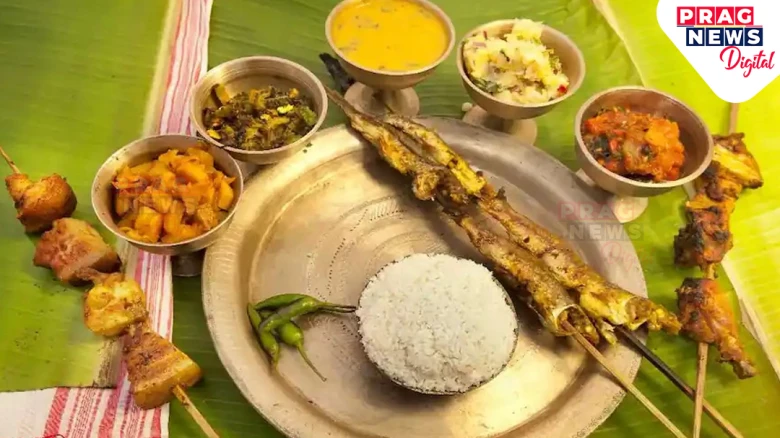This is Assam’s most famous dish, and for good reason. Imagine tender river fish swimming in a light, tangy broth that wakes up every taste buds. The magic comes from souring agents like elephant apple (ou tenga), or dried mangosteen (thekera)-ingredients that you won’t find anywhere else.
What makes it special: It’s served first in traditional meals to prep your palate for what’s coming. The fish is barely spiced, letting that beautiful sour-sweet flavour take the centre stage. One spoonful with rice and you’ll understand why Assamese people are so passionate about this dish.
Here’s where Assam gets really interesting. Khaar uses an Alkaline extract made from Burning banana stems and peels – a technique that’s older that recorded history. This isn’t just cooking, its chemistry meets tradition.
Why it’s amazing:The Alkali tenderizes meat beautifully and gives vegetables a unique, mildly butter taste that’s incredibly cleansing, it’s like having a healthy tonic before starting your meal.
4. Pitha – Festival Food That’ll Steal Your Heart
These aren’t just rice cakes– they’re edible art pieces. During Bihu Festivals, families gather to make dozens of varieties, each more delicious than the last. Til PItha (stuffed with sesame and jaggery) and Sunga Pitha (cooked inside bamboo tubes) are the superstars.
The bamboo magic: Sunga Pitha is cooked by stuffing rice flour mixture into young bamboo tubes and roasting over coals. The bamboo imparts an earthy flavour that’s absolutely unforgettable.
5. Bamboo Shoot Curry (Khorisa) – Forest Flavours on Your Plate
Fresh bamboo shoots are good, but fermented bamboo shoots? That’s where the magic happens. After months of aging in earthen pots, they develop complex, umami rich flavours that transform any simple curry into something extraordinary.
Acquired taste alert: The aroma is intense, but once you’re hooked, you’re hooked for life. It’s like the blue cheese of Asian vegetables – polarizing but extremely addictive.
6. Duck Curry (Hanh) – The Celebration Special
When Assamese families have something to celebrate, duck curry appears on the table. This isn’t everyday food – it’s special occasion magic. The duck becomes so tender it falls off the bone, while bottle gourd adds sweetness to balance the rich meat.
Cultural Moment: Preparing duck curry is often a family affair, with multiple generations cooking together. It’s as much about bonding as it is about eating.
7. Lau Ghonto – Simple Ingredients, Complex Satisfaction
Bottle Gourd might sound boring, but in Assamese hands, it becomes something beautiful. Slow-cooked until it creates its own light gravy, seasoned minimally to let the vegetable’s natural sweetness shine through.
Seasonal wisdom: Popular during monsoons when fresh gourds are abundant, the dish proves that the best cooking often means doing less, not more.
8. Silkworm Pupae Curry (Eri Polu) – The Ultimate Adventure Food
This one’s not for the faint-hearted, but hear us out. These pupae are collected after silk extraction, making this the ultimate zero-waste protein. They taste nutty and rich, with a texture surprisingly similar to prawns.
Sustainability superstar: This dish represents everything beautiful about traditional cuisine – nothing goes to waste, and every protein source is valued.
9. Fish Curry with Taro Leaves (Kosu Saag Maor Jool) – Nutrition Powerhouse
Taro leaves might look intimidating, but when cooked properly, they create a thick, nutritious gravy that hugs fresh fish pieces perfectly. The leaves break down during cooking, creating a unique texture that’s both rustic and refined.
Monsoon Favourite: Peak season for taro leaves means this curry appears frequently during the rains, providing comfort and nutrition when you need it most.
10. Rice Beer (Apong/Xaj) – Liquid Hospitality
This isn’t just a drink – it’s liquid culture. Made through natural fermentation using wild yeasts passed down through generations, each family’s rice beer tastes slightly different. Its mildly alcoholic, refreshingly light, and absolutely essential to understanding Assamese hospitality.
Cultural Significance: offering rice beer to guests is a sign of respect. During Bihu festivals, sharing homemade rice beer strengthens community bonds and celebrates the harvest.
Assamese cuisine is like finding a hidden treasure chest of flavours. It challenges everything you think you know about Indian food while celebrating Ingredients and techniques that are uniquely Northeastern. These dishes aren’t just meals- they’re stories of a culture that values sustainability, seasonality, and the pure joy of sharing good food.
Whether you’re planning a trip to Assam or hunting down these ingredients to try at home, approach each dish with curiosity and an open mind. Some flavours might surprise you, Some others might challenge you, but all of them will give you a taste of one of India’s most fascinating food cultures.

Leave A Comment